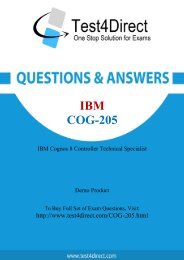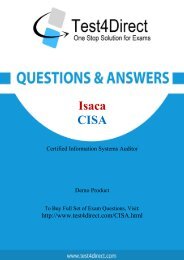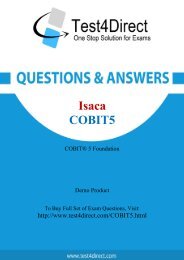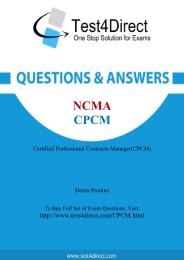Pass CEH-001 Exam Easily with BrainDumps
Test4Direct provides latest PDF questions of GAQM CEH-001 exam. You have an opportunity to pass the GAQM CEH-001 exam in one go. Test4Direct is most accurate source to prepare GAQM CEH-001 exam as your success will become site’s responsibility after purchasing CEH-001 exam product. There are also lots of discounts and promotion offers that you can avail. Let’s try a free demo http://www.test4direct.com/CEH-001.html
Test4Direct provides latest PDF questions of GAQM CEH-001 exam. You have an opportunity to pass the GAQM CEH-001 exam in one go. Test4Direct is most accurate source to prepare GAQM CEH-001 exam as your success will become site’s responsibility after purchasing CEH-001 exam product. There are also lots of discounts and promotion offers that you can avail. Let’s try a free demo http://www.test4direct.com/CEH-001.html
You also want an ePaper? Increase the reach of your titles
YUMPU automatically turns print PDFs into web optimized ePapers that Google loves.
GAQM<br />
<strong>CEH</strong>-<strong>001</strong><br />
Certified Ethical Hacker (<strong>CEH</strong>)<br />
Demo Product<br />
To Buy Full Set of <strong>Exam</strong> Questions, Visit:<br />
http://www.test4direct.com/<strong>CEH</strong>-<strong>001</strong>.html
Question: 1<br />
Which of the following countermeasure can specifically protect against both the MAC Flood and MAC<br />
Spoofing attacks?<br />
A. Configure Port Security on the switch<br />
B. Configure Port Recon on the switch<br />
C. Configure Switch Mapping<br />
D. Configure Multiple Recognition on the switch<br />
Question: 2<br />
Question: 3<br />
Question: 4<br />
Answer: A<br />
Jimmy, an attacker, knows that he can take advantage of poorly designed input validation routines to<br />
create or alter SQL commands to gain access to private data or execute commands in the database.<br />
What technique does Jimmy use to compromise a database?<br />
A. Jimmy can submit user input that executes an operating system command to compromise a target<br />
system<br />
B. Jimmy can gain control of system to flood the target system <strong>with</strong> requests, preventing legitimate<br />
users from gaining access<br />
C. Jimmy can utilize an incorrect configuration that leads to access <strong>with</strong> higher-than expected<br />
privilege of the database<br />
D. Jimmy can utilize this particular database threat that is an SQL injection technique to penetrate a<br />
target system<br />
Answer: D<br />
This IDS defeating technique works by splitting a datagram (or packet) into multiple fragments and<br />
the IDS will not spot the true nature of the fully assembled datagram. The datagram is not<br />
reassembled until it reaches its final destination. It would be a processor-intensive task for IDS to<br />
reassemble all fragments itself, and on a busy system the packet will slip through the IDS onto the<br />
network. What is this technique called?<br />
A. IP Routing or Packet Dropping<br />
B. IDS Spoofing or Session Assembly<br />
C. IP Fragmentation or Session Splicing<br />
D. IP Splicing or Packet Reassembly<br />
Answer: C<br />
If a competitor wants to cause damage to your organization, steal critical secrets, or put you out of
usiness, they just have to find a job opening, prepare someone to pass the interview, have that<br />
person hired, and they will be in the organization.<br />
How would you prevent such type of attacks?<br />
A. It is impossible to block these attacks<br />
B. Hire the people through third-party job agencies who will vet them for you<br />
C. Conduct thorough background checks before you engage them<br />
D. Investigate their social networking profiles<br />
Question: 5<br />
Question: 6<br />
Answer: C<br />
This type of Port Scanning technique splits TCP header into several packets so that the packet filters<br />
are not able to detect what the packets intends to do.<br />
A. UDP Scanning<br />
B. IP Fragment Scanning<br />
C. Inverse TCP flag scanning<br />
D. ACK flag scanning<br />
Answer: B<br />
Joel and her team have been going through tons of garbage, recycled paper, and other rubbish in
order to find some information about the target they are attempting to penetrate. How would you<br />
call this type of activity?<br />
A. Dumpster Diving<br />
B. Scanning<br />
C. CI Gathering<br />
D. Garbage Scooping<br />
Question: 7<br />
Question: 8<br />
Answer: A<br />
Anonymizer sites access the Internet on your behalf, protecting your personal information from<br />
disclosure. An anonymizer protects all of your computer's identifying information while it surfs for<br />
you, enabling you to remain at least one step removed from the sites you visit. You can visit Web<br />
sites <strong>with</strong>out allowing anyone to gather information on sites visited by you. Services that provide<br />
anonymity disable pop-up windows and cookies, and conceal visitor's IP address. These services<br />
typically use a proxy server to process each HTTP request. When the user requests a Web page by<br />
clicking a hyperlink or typing a URL into their browser, the service retrieves and displays the<br />
information using its own server. The remote server (where the requested Web page resides)<br />
receives information on the anonymous Web surfing service in place of your information. In which<br />
situations would you want to use anonymizer? (Select 3 answers)<br />
A. Increase your Web browsing bandwidth speed by using Anonymizer<br />
B. To protect your privacy and Identity on the Internet<br />
C. To bypass blocking applications that would prevent access to Web sites or parts of sites that you<br />
want to visit.<br />
D. Post negative entries in blogs <strong>with</strong>out revealing your IP identity<br />
What type of attack is shown in the following diagram?<br />
Answer: B, C, D
A. Man-in-the-Middle (MiTM) Attack<br />
B. Session Hijacking Attack<br />
C. SSL Spoofing Attack<br />
D. Identity Stealing Attack<br />
Answer: A<br />
Question: 9<br />
Jack Hacker wants to break into Brown Co.'s computers and obtain their secret double fudge cookie<br />
recipe. Jack calls Jane, an accountant at Brown Co., pretending to be an administrator from Brown<br />
Co. Jack tells Jane that there has been a problem <strong>with</strong> some accounts and asks her to verify her<br />
password <strong>with</strong> him ''just to double check our records.'' Jane does not suspect anything amiss, and<br />
parts <strong>with</strong> her password. Jack can now access Brown Co.'s computers <strong>with</strong> a valid user name and<br />
password, to steal the cookie recipe. What kind of attack is being illustrated here?<br />
A. Reverse Psychology<br />
B. Reverse Engineering<br />
C. Social Engineering<br />
D. Spoofing Identity<br />
E. Faking Identity<br />
Question: 10<br />
How do you defend against ARP Spoofing? Select three.<br />
A. Use ARPWALL system and block ARP spoofing attacks<br />
B. Tune IDS Sensors to look for large amount of ARP traffic on local subnets<br />
C. Use private VLANS<br />
D. Place static ARP entries on servers, workstation and routers<br />
Question: 11<br />
Answer: C<br />
Answer: A, C, D<br />
Explanation:<br />
ARPwall is used in protecting against ARP spoofing.<br />
Incorrect answer:<br />
IDS option may works fine in case of monitoring the traffic from outside the network but not from<br />
internal hosts.<br />
TCP SYN Flood attack uses the three-way handshake mechanism.<br />
1. An attacker at system A sends a SYN packet to victim at system B<br />
2. System B sends a SYN/ACK packet to victim A<br />
3. As a normal three-way handshake mechanism system A should send an ACK packet to system B,<br />
however, system A does not send an ACK packet to system B. In this case client B is waiting for an<br />
ACK packet from client A
This status of client B is called _________________<br />
A. "half-closed"<br />
B. "half open"<br />
C. "full-open"<br />
D. "xmas-open"<br />
Answer: B<br />
Question: 12<br />
Lori is a Certified Ethical Hacker as well as a Certified Hacking Forensics Investigator working as an IT<br />
security consultant. Lori has been hired on by Kiley Innovators, a large marketing firm that recently<br />
underwent a string of thefts and corporate espionage incidents. Lori is told that a rival marketing<br />
company came out <strong>with</strong> an exact duplicate product right before Kiley Innovators was about to<br />
release it. The executive team believes that an employee is leaking information to the rival company.<br />
Lori questions all employees, reviews server logs, and firewall logs; after which she finds nothing.<br />
Lori is then given permission to search through the corporate email system. She searches by email<br />
being sent to and sent from the rival marketing company. She finds one employee that appears to be<br />
sending very large email to this other marketing company, even though they should have no reason<br />
to be communicating <strong>with</strong> them. Lori tracks down the actual emails sent and upon opening them,<br />
only finds picture files attached to them. These files seem perfectly harmless, usually containing<br />
some kind of joke. Lori decides to use some special software to further examine the pictures and<br />
finds that each one had hidden text that was stored in each picture. What technique was used by the<br />
Kiley Innovators employee to send information to the rival marketing company?<br />
A. The Kiley Innovators employee used cryptography to hide the information in the emails sent<br />
B. The method used by the employee to hide the information was logical watermarking<br />
C. The employee used steganography to hide information in the picture attachments<br />
D. By using the pictures to hide information, the employee utilized picture fuzzing<br />
Question: 13<br />
Answer: C<br />
You run nmap port Scan on 10.0.0.5 and attempt to gain banner/server information from services<br />
running on ports 21, 110 and 123. Here is the output of your scan results:
Which of the following nmap command did you run?<br />
A. nmap -A -sV -p21, 110, 123 10.0.0.5<br />
B. nmap -F -sV -p21, 110, 123 10.0.0.5<br />
C. nmap -O -sV -p21, 110, 123 10.0.0.5<br />
D. nmap -T -sV -p21, 110, 123 10.0.0.5<br />
Answer: C<br />
Question: 14<br />
How do you defend against Privilege Escalation?<br />
A. Use encryption to protect sensitive data<br />
B. Restrict the interactive logon privileges<br />
C. Run services as unprivileged accounts<br />
D. Allow security settings of IE to zero or Low<br />
E. Run users and applications on the least privileges<br />
Answer: A, B, C, E
Question: 15<br />
What does ICMP (type 11, code 0) denote?<br />
A. Source Quench<br />
B. Destination Unreachable<br />
C. Time Exceeded<br />
D. Unknown Type<br />
Answer: C
THANKS FOR TRYING THE DEMO OF OUR PRODUCT<br />
Visit Our Site to Purchase the Full Set of Actual <strong>CEH</strong>-<strong>001</strong> <strong>Exam</strong> Questions With Answers.<br />
http://www.test4direct.com/<strong>CEH</strong>-<strong>001</strong>.html<br />
We Also Provide Practice <strong>Exam</strong> Software That Simulates Real <strong>Exam</strong> Environment And Has<br />
Many Self-Assessment Features. Download Free Product Demo From:<br />
http://www.test4direct.com/<strong>CEH</strong>-<strong>001</strong>.html<br />
Money Back Guarantee<br />
Check Out Our Customer Testimonials

















